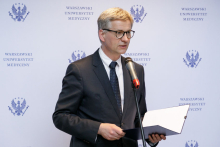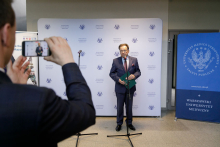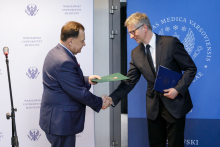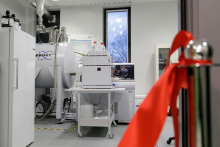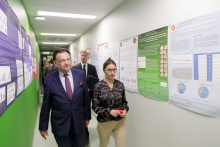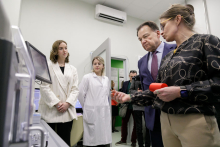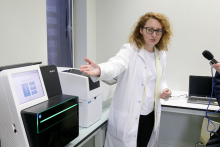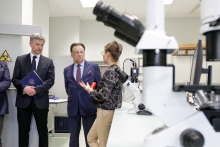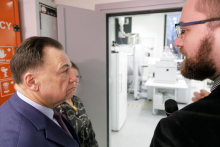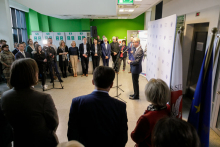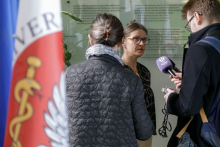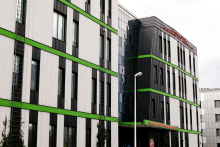The opening of the facilities of the Laboratory of Regenerative Medicine MUW took place on March 23 in the building of the Center for Preclinical Research. The symbolic ribbon was cut by the Marshal of the Mazovian Voivodeship Adam Struzik, Prof. Piotr Pruszczyk, Vice Rector for Science and Technology Transfer MUW, Sebastian Gojdź from the Directorate-General for Regional and Urban Policy of the European Commission, Mariusz Frankowski, Director of the Mazovian Unit for Implementation of EU Programs, and Prof. Magdalena Kucia, head of the Laboratory of Regenerative Medicine MUW.
Support from the European Union and the Mazovian Voivodeship
In 2018, MUW signed a contract for the "Center for Preclinical Research and Technology - CePT II" project. Its goal was to intensify research and implementation work in close cooperation with business partners. The realization was possible thanks to the European Union funds obtained within the framework of the Regional Operational Program of the Mazovian Voivodeship for 2014-2020. It was thanks to the tremendous support of the Marshal's Office of the Mazovian Voivodeship, the Directorate-General for Regional and Urban Policy of the European Commission and the Mazovian Unit for Implementation of EU Programs that about 20 pieces of equipment ranked among the world's most modern research infrastructure were delivered to the Laboratory of Regenerative Medicine, headed by Prof. Magdalena Kucia.
Prof. Piotr Pruszczyk: - Laboratory of Regenerative Medicine is unique. Fewer than 10 facilities in Europe have laboratory equipment of this class. It is a very successful investment in the future of medicine and technology in Poland. We hope for further fruitful investment cooperation with the local government of the Mazovian Voivodeship.
Marshal Adam Struzik: - Any investment in science is an investment in a better future and the development of Mazovia. The EU funds that made it possible to build the laboratory, which is being opened today, are a huge support for scientific and research projects in our region. We are just starting a new agenda of European funds and I hope that thanks to them we will be able to subsidize more innovative research projects. I congratulate you on such a great investment and wish you much success in the scientific and research fields.
State-of-the-art equipment
The purchased equipment will enable the Laboratory's scientists to conduct the most technologically advanced research, including targeted therapies that will be implemented at MUW teaching hospitals in the future. The Laboratory's potential to provide services to businesses has also increased, which strengthens cooperation between research units and industry.
Prof. Magdalena Kucia, head of the Laboratory of Regenerative Medicine MUW: - Thanks to funding from the Operational Program and EU funds, it was possible today to open a laboratory that brings together scientific staff united by experience, scientific passion and skills. Our overarching goal is to create new solutions, to develop new innovative protocols in regenerative medicine - a field of science that aims to repair organs and tissues and improve the patient's quality of life.
Among other things, the Laboratory of Regenerative Medicine received: world’s unique flow cytometer that allows the isolation of cells and nanoparticles from any biological material; a mass spectrometry system with revolutionary resolution, allowing the measurement of the concentration of any molecule, from a protein, drug derivative, cell fragment, etc.; a personal high-throughput sequencer allowing sequencing of up to 120Gb, while ensuring speed, ease of use and cost accessibility.
Prof. Magdalena Kucia: - We have managed to create a place that allows us to work from A to Z in science. It's such a dream model.
About what the Laboratory of Regenerative Medicine does talks Prof. Magdalena Kucia in the interview "We are developing regenerative medicine at MUW."
More about CePT II
CePT II is a project implemented by a scientific consortium consisting of: Medical University of Warsaw (Leader), University of Warsaw and the Institute of High Pressure Physics of the Polish Academy of Sciences. Research conducted under the project covered three thematic areas: regenerative medicine, nano medicine and verification of innovative technologies through the use of mass spectrometry, isotopic techniques and 3D prototyping. As part of the CePT II project, the consortium purchased specialized apparatus and equipment for research and development purposes. Their value is about 45 million PLN.
Prof. Piotr Pruszczyk: - Joint action has great power. Without cooperation, we would not be here today, so I sincerely thank our consortium members.
At the opening of the Laboratory, in addition to those mentioned, also present were: Prof. Pawel Włodarski, Vice Rector for International Relations, Development and Promotion, Prof. Roman Smolarczyk and Dr. Bogdan Lang, members of the University Council MUW, representatives of the CePT II consortium members: prof. Witold Łojkowski, Head of the Laboratory of Nanostructures, Institute of High Pressure Physics of the Polish Academy of Sciences, Prof. Zygmunt Lalak, Vice Rector for Research of the University of Warsaw, and Dr. Zbigniew Rogulski, Vice Dean for Infrastructure and Development of the Faculty of Chemistry UW. And also Prof. Mariusz Gujski, Dean of the Faculty of Health Sciences, Piotr Luliński, MD, PhD, Dean of the Faculty of Pharmacy, Prof. Michal Grąt, Director of the MUW Doctoral School, Beata Piekutowska, Director of the CePT Office, Dorota Szubstarska, Director of the Science Division of Technology Transfer, Marta Kijak-Bloch, Chancellor, deputy chancellors, vice deans of faculties, heads of scientific units.

